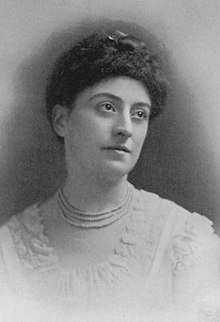Ethel Gordon Fenwick
Ethel Gordon Fenwick (née Manson; 26 January 1857 – 13 March 1947) was a British nurse who played a major role in the History of Nursing in the United Kingdom. She campaigned to procure a nationally recognised certificate for nursing, to safeguard the title "Nurse", and lobbied Parliament to pass a law to control nursing and limit it to "registered" nurses only.
Ethel Gordon Fenwick | |
|---|---|
 | |
| Born | Ethel Gordon Manson 26 January 1857 |
| Died | 13 March 1947 (aged 90) |
| Nationality | British |
| Occupation | nurse |
| Known for | President of the International Council of Nurses |
Biography
She was born Ethel Gordon Manson in the Morayshire town of Elgin in Scotland, the daughter of a wealthy doctor who died early in her life. Ethel's mother then married George Storer, a Member of Parliament. She was educated privately at Middlethorpe Hall, Middlethorpe, Yorkshire. At the age of 21 she commenced nurse training at the Children's Hospital in Nottingham as a paying probationer nurse, and then at Manchester Royal Infirmary. Her expertise was soon noted and it was not long before she left for London, where she worked in hospitals in Whitechapel, and Richmond.
In 1881, at the age of 24, Ethel was appointed Matron of St Bartholomew's Hospital, a post she held until 1887 when she resigned her post to marry Dr Bedford Fenwick, becoming known professionally as Mrs Bedford Fenwick.[1]
.jpg)
She was the founder of the Royal British Nurses' Association in 1887.[2] She was instrumental in founding Florence Nightingale International Foundation, the premier foundation of the International Council of Nurses, and was its president for the first five years. She extended significantly the training period for nurses, and campaigned for the state registration of nurses in the United Kingdom. This was achieved through the Nurses Registration Act 1919, and Ethel Gordon Fenwick appears as "Nurse No. 1" when the register opened in 1923. (New Zealand had been the first country to introduce nurse registration in 1902, when Ellen Dougherty became the first registered nurse in the world.)
Ethel Fenwick acquired the Nursing Record in 1893 and became its editor in 1903. It was renamed The British Journal of Nursing and through its pages for the next 54 years her thinking and her beliefs are clearly revealed. She disagreed with Florence Nightingale and with Henry Burdett about registration of nurses. She believed that there was a need for training to a recognised standard and this meant confining entry to the profession to the daughters of the higher social classes. She opposed paying nurses in training, because it attracted the wrong sort of girl. She was very keen to see control over domiciliary nursing.[3]
In 1927 she established the British College of Nurses with an endowment of £100,000 from a grateful patient of Dr Fenwick. She was president, and he was treasurer, for life.
In 1999 an English Heritage "blue plaque" was attached to her former home at 20 Upper Wimpole Street, London.[4]
References
- Hector, Winifred (1973). The Work of Mrs. Bedford Fenwick and the Rise of Professional Nursing. London: Royal College of Nursing.
- "The Origins of The Royal British Nurses' Association". Royal British Nurses Association. Archived from the original on 2 April 2015. Retrieved 6 June 2017.
- Abel-Smith, Brian (1960). A History of the Nursing Profession. London: Heinemann. p. 64.
- Plaques of London: Ethel Gordon Fenwick
Sources
- McGann, Susan. "Fenwick, Ethel Gordon (1857–1947)", Oxford Dictionary of National Biography, Oxford University Press, 2004; online edn, Jan 2010 accessed 7 Oct 2010
- "ETHEL GORDON FENWICK, S.R.N.. A SHORT OUTLINE OF HER LIFE AND WORK". The British Journal of Nursing Volume 95, Page 37 (April 1947) [pdf]
External links
| Wikisource has the text of a 1922 Encyclopædia Britannica article about "Ethel Gordon Fenwick". |
- Florence Nightingale International Foundation
- The Royal British Nurses' Association: Registration of Nurses
- The University of Sheffield: Nursing and Midwifery History UK
- Fenwick, Ethel Gordon (6 January 1900). "The Evolution of the Trained Nurse". The Outlook. 64: 56–67. Retrieved 30 July 2009.
- Main, Jenny (1978). Ethel Bedford-Fenwick: The First Nurse. Milton Brodie: Librario. ISBN 1-904440-29-0.
- McGann, Susan (1992). Battle of the Nurses: a study of eight women who influenced the development of professional nursing 1880-1930. London: Scutari. ISBN 1-871364-62-0.
- RCN: Historical biographies - "Mrs Bedford Fenwick: A Restless Genius".